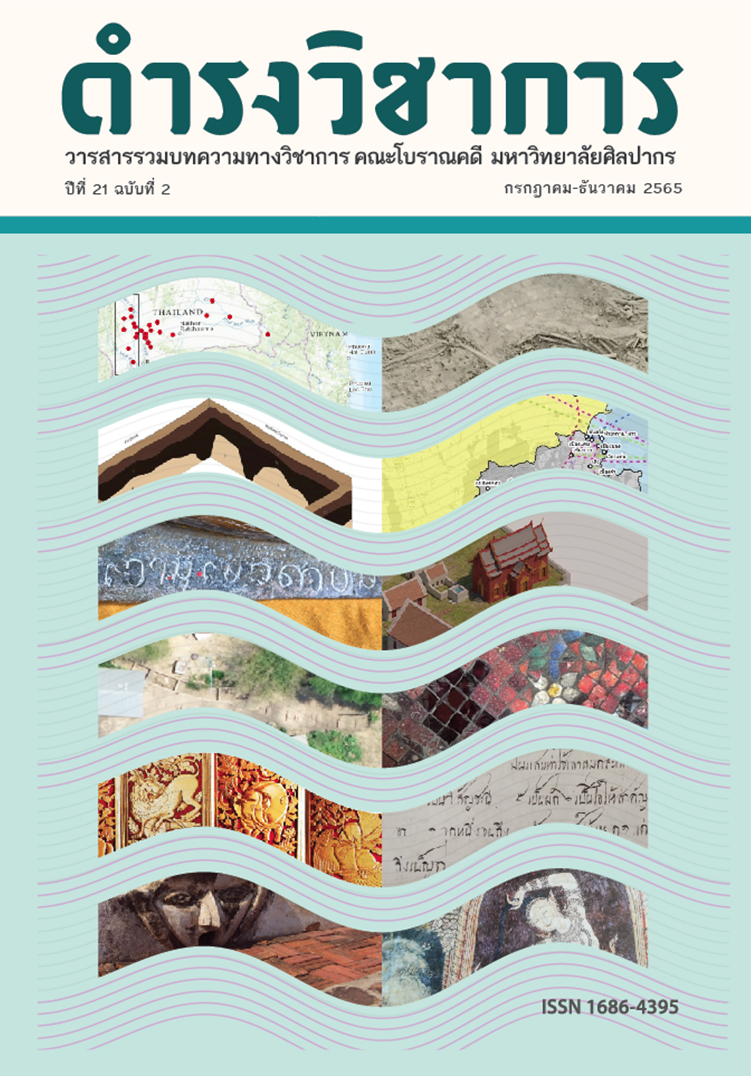Inscriptions in Wat Lam Chang: Importance to the Community and the Locality
Keywords:
Chiang Mai history, Lam Chang monastery, Lan Na inscriptionsAbstract
This article aims to study eleven inscriptions that have been kept in Lam Chang monastery, Si Phum Subdistrict, Muang District, Chiang Mai Province, which consists of three bronze Buddha statues, a bronze hermit statue, a lime Buddha statue, and six wooden Buddha statues. The objective is to present the inscriptions of Wat Lam Chang, which are important to the local history but have not been published yet. The inscriptions are transliterated and translated from ancient Lan Na scripts into present Thai characters and language to get more information on the history of the Lam Chang community and Chiang Mai City and examined together with secondary sources. The research found that all the inscriptions in Wat Lam Chang are sacred statues. They are made from the late 20th to 25th Buddhist centuries, mostly inscribed in Dham Lan Na and Fak Kham scripts. However, one of the inscriptions created in the 25th Buddhist century appears to have used Thai characters together with the Dham Lan Na script in the same object. The inscriptions of Wat Lam Chang pass on historical information in various fields that indicate the prosperity of the Lan Na Kingdom in the past. Lan Na scripts and language and the Buddhist arts are transmitted from the statues, moreover, they provide information on the name of monasteries, the name of the person, the scale of the object's weight, beliefs about donating of Buddha statues including the tradition that binds the Lam Chang community to the inscriptions.
References
กรมศาสนา, 2514. พระไตรปิฎก ฉบับหลวง เล่ม 25. กรุงเทพฯ: กรมการศาสนา.
กรรณิการ์ วิมลเกษม, 2527. อักษรฝักขามที่พบในศิลาจารึกภาคเหนือ. กรุงเทพฯ: ภาควิชาภาษาตะวันออก คณะโบราณคดี มหาวิทยาลัยศิลปากร.
ไขศรี ศรีอรุณ, 2546. พระพุทธรูปปางต่าง ๆ ในสยามประเทศ. พิมพ์ครั้งที่ 3. กรุงเทพฯ: บริษัท มติชน จำกัด (มหาชน).
คณะอนุกรรมการตรวจสอบและชำระตำนานพื้นเมืองเชียงใหม่, 2538. ตำนานพื้นเมืองเชียงใหม่ ฉบับเชียงใหม่ 700 ปี. เชียงใหม่: ศูนย์วัฒนธรรมจังหวัดเชียงใหม่ และศูนย์ศิลปวัฒนธรรม สถาบันราชภัฏเชียงใหม่.
จิตรลดา อินนันชัย, 2557. รายงานการขุดแต่งโบราณสถาน โครงการบูรณะเจดีย์และมณฑป วัดล่ามช้าง ตำบลศรีภูมิ อำเภอเมือง จังหวัดเชียงใหม่. เชียงใหม่: สำนักศิลปากรที่ 8 เชียงใหม่.
นัยนา โปร่งธุระ, 2525. “อักษรธรรมลานนา.” วิทยานิพนธ์ศิลปศาสตรมหาบัณฑิต สาขาวิชาจารึกภาษาไทย ภาควิชาภาษาตะวันออก มหาวิทยาลัยศิลปากร.
ประเสริฐ ณ นคร, 2534. “ประวัติศาสตร์ล้านนาจากจารึก.” ใน งานจารึกและประวัติศาสตร์ของประเสริฐ ณ นคร. นครปฐม: โรงพิมพ์ศูนย์ส่งเสริมและฝึกอบรมการเกษตรแห่งชาติ มหาวิทยาลัยเกษตรศาสตร์ กำแพงแสน.
พระครูอดุลสีลกิตติ์, 2549. การปกครองคณะสงฆ์แบบโบราณ ประวัติศาสตร์พุทธศาสนาในล้านนา. เชียงใหม่: แสงศิลป์.
พระพรหมคุณาภรณ์ (ป. อ. ปยุตฺโต), 2559. พจนานุกรมพุทธศาสตร์ ฉบับประมวลธรรม. พิมพ์ครั้งที่ 34. ม.ป.ท.: มูลนิธิการศึกษาเพื่อสันติภาพ พระธรรมปิฎก (ป. อ. ปยุตฺโต).
ศูนย์วัฒนธรรมจังหวัดเชียงใหม่ สถาบันราชภัฏเชียงใหม่, 2538. ตำนานพื้นเมืองเชียงใหม่. เชียงใหม่: มิ่งเมือง.
สมหมาย เปรมจิตต์ และคณะ, 2544. โครงการอนุรักษ์พระคัมภีร์ล้านนา: ปริวรรตและวิเคราะห์เนื้อหา. เชียงใหม่: มิ่งเมือง.
สรัสวดี อ๋องสกุล, 2561. ประวัติศาสตร์ล้านนา ฉบับสมบูรณ์. พิมพ์ครั้งที่ 12. กรุงเทพฯ: สำนักพิมพ์อมรินทร์.
สำนักงานเจ้าคณะอำเภอเมืองเชียงใหม่, 2548. ประวัติวัดในเขตอำเภอเมืองเชียงใหม่. เชียงใหม่: นันทพันธ์.
แสวง มาละแซม, 2530. พิธีบรรจุพระบรมสารีริกธาตุและอัญเชิญพระสมเด็จพระยุพราชประดิษฐานเหนือแท่นแก้ว ณ ธรรมสถาน โรงเรียนยุพราชวิทยาลัย 18, 23 กันยายน 2530. เชียงใหม่: โรงเรียนยุพราชวิทยาลัย.
อรุณรัตน์ วิเชียรเขียว, 2539. วัดร้างในเวียงเชียงใหม่. พิมพ์ครั้งที่ 2. เชียงใหม่: สุริวงศ์บุ๊คเซนเตอร์
สัมภาษณ์
พระครูปลัดอานนท์ วิสุทฺโธ, 2563. เจ้าอาวาสวัดล่ามช้าง. สัมภาษณ์, 16 ตุลาคม.
คำปัน สิทธิเป็ง, 2563. ประชาชนอาวุโสชุมชนล่ามช้าง. สัมภาษณ์, 16 ตุลาคม.
ศรีเลา เกษพรหม, 2564. ผู้เชี่ยวชาญด้านอักษรโบราณล้านนา. สัมภาษณ์, 4 ธันวาคม.
Downloads
Published
Issue
Section
License
Copyright (c) 2022 Damrong Journal of The Faculty of Archaeology Silpakorn University

This work is licensed under a Creative Commons Attribution-NonCommercial-NoDerivatives 4.0 International License.
บทความนี้เป็นผลงานของข้าพเจ้าแต่เพียงผู้เดียว และ/หรือเป็นผลงานของข้าพเจ้าและผู้ร่วมงาน ตามชื่อที่ระบุในบทความจริง และเป็นผลงานที่มิได้ถูกนำเสนอหรือตีพิมพ์ที่ใดมาก่อน





